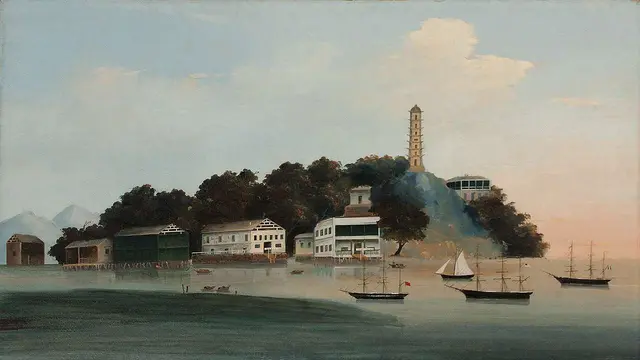There is eager anticipation in yachting circles following the announcement that the 2017-18 Volvo Ocean Race will include a stopover in Hong Kong, but even this prestigious event is unlikely to come close to matching the greatest sailing contest of all time, which started in southern China and concluded with great drama in London, 150 years ago this week.
“It is probable that no race ever sailed on blue water created so much excitement as the great tea race of 1866,” wrote the late maritime writer Basil Lubbock.
Capturing international media attention and enthralling the public, the race that year to deliver the first tea of the season, which began in Fuzhou on May 28, had all the danger, speed and speculative frenzy of a Grand National.
“Every man with a nautical cut to his jib had a bet upon the result, whilst the rival owners, agents and shippers wagered huge sums,” wrote Lubbock, and that meant a lot of money changing hands in Hong Kong.
The race pitted the fastest and most beautiful sailing ships ever built against one another as they vied to win the 10 shillings per ton premium offered by the city’s merchants for the first Chinese tea of the season delivered to the London markets. Commanded and crewed by the most skilled professional seamen of the day, these graceful tea clippers raced some 16,000 nautical miles to the British capital for big cash prizes and a place in the history books.
A painting of the Taeping (left) and Ariel competing in the great tea race of 1866. Photo: Alamy
Correspondents sent by London and Hong Kong newspapers held their collective breath on May 24, 1866, while the crews of 16 clippers waited impatiently at the Pagoda anchorage on the Min River, some 15 nautical miles downstream from Fuzhou town, as their cargos of fresh tea arrived by sampan. The ships – with names such as Taeping, Chinaman, Black Prince and Fiery Cross – were listed in the shipping pages of the Hong Kong press, and the London tea markets anxiously awaited news by telegraph of the first vessel to depart, laden with precious Fujian tea.
A media frenzy will too, of course, accompany the Volvo Ocean Race. Each boat will have aboard a multimedia reporter to capture the drama and the dedicated competitors’ village at Kai Tak will have a state-of-the-art media centre. In sailing circles, the event is rivalled only by the America’s Cup and the Olympic Games races in terms of prestige. But the great tea race of 1866 had an attraction that extended beyond nautical enthusiasts in what became known as “the golden age of sail”.
The best captains were household names with a fame comparable to that of today’s Formula One champions, albeit without the pampered lifestyles. Born in 1826, on the remote Hebridean island of Tiree, in northern Scotland, Captain Donald MacKinnon, of the Taeping, had the classic profile of a clipper captain. An old sea dog, he had taken to the oceans at the age of 18 as an apprentice in the barque Glencairn and was awarded his master mariner’s certificate at the age of 23. His eldest son, William, was born at sea and MacKinnon missed the birth and death (at the age of seven weeks) of his second child, in June 1858, because he was on a voyage.
“The sea never changes and the race around the world is still a human challenge and a battle against the elements,” says Jon Bramley, director of news and media for the Volvo Ocean Race. In both eras, the best skippers walked the fine line between maximum velocity and disaster.
In the 19th century, multiple race winner Richard “Dickie” Robinson, of the Fiery Cross, was said to be worth an extra half-knot in speed to any ship he captained. The clipper Robinson feared most in 1866 was the newly built Ariel, commanded by the experienced and respected John Melville Keay. The Ariel attracted admiring glances from even her fiercest rivals and Keay, a man not known for emotional ebullience, was once inspired to write of his ship in surprisingly romantic terms: “Ariel was perfect beauty to every nautical man who saw her; in symmetrical grace and proportion of hull spars, sails, rigging and finish, she satisfied the eye and put all in love with her.”
Her favoured status was reflected in the fact that shipping agents elected to load Ariel first and, in 1866, that meant that Keay, a veteran of several tea races himself, paced the deck as his crew of 40 helped supervise the stowage of 1.2 million pounds (560 tons) of tea contained in thousands of wooden chests.
First loaded, Ariel had the advantage of weighing anchor ahead of her rivals. She could also make use of one of the few steam tugs available to assist with the tricky narrow exit of the river over a shallow sand bar and out into the South China Sea.
A painting of Taitsing, by David Michael Hartigan Little.Photo: Post magazine
Fiery Cross was an apposite name for a vessel commanded by Robinson, who had a reputation for being both. The pugnacious skipper was so incensed by Ariel’s early departure that he ordered his ship to leave without the necessary documentation, which theChina Maildescribed as “Fiery Cross bolting without her papers and even without signing the bills of lading”.
“By this manoeuvre she got twelve hours start of the fleet from Pagoda anchorage and drove the captain of the Serica into a state bordering on insanity,” the report continued.
(China Daily)
 简体中文
简体中文



